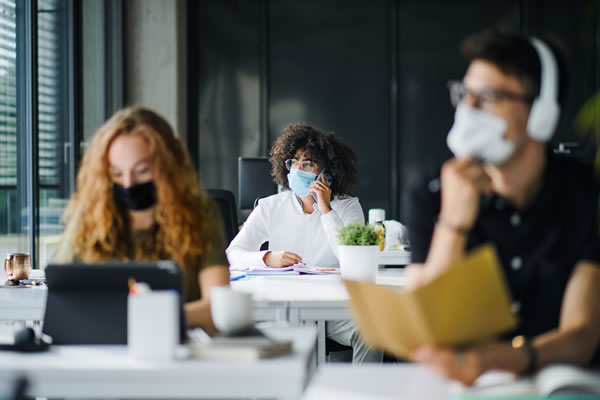Colleges across the country have been scrambling to pandemic-proof their campuses through everything from facial recognition technology to contact-tracing apps.
The pandemic continues to spread its influence throughout college campuses across America, with varied responses from higher education officials. Some have chosen to completely shut down and go remote, while others have decided to push forward and offer the full on-campus experience for their students. Still others have gone the hybrid route, offering a blend of in-person and remote choices.
For those colleges that have welcomed students back to campus, at least in some capacity, there’s no doubt been pressure over the last few months to ensure a solid plan was in place to protect students, faculty and staff. Technology is a huge part of that, taking the form of anything from thermal recognition to social distance monitoring.
It’s quite clear that technology is no longer seen as a utility working in the background; rather, it’s a strategic asset that is critical to every institution’s success. Since last spring, colleges and universities the world over have had to work at hyperspeed to serve students and better work together in the shadow of this global pandemic, points out Inside Higher Ed. From virtual classes to tracking apps for on-campus attendance, leaders – with a boost from technology – have been doing whatever it takes to get their institutions through this crisis.
Let’s take an inside look at what colleges and universities are doing to contain, educate, and protect.
Yes, There Really is an App For That
You can listen to music, watch movie trailers, make a budget and get the weather through apps on your smart phone. 2020 has introduced yet another thing you can do with an app, and that’s attempt to pandemic-proof your campus.
Take Suffolk University in Boston, for example. They’re using an app called CoVerified, a comprehensive COVID-19 platform designed for self-attestation, health screening, contact tracing, test-result management, and monitoring of COVID-19 viral transmission trends and rates on campus.
Suffolk University students, staff and faculty are using this app to monitor, measure and report their daily health screenings, as well as to fill out a self-attestation that will facilitate seamless access to campus buildings and events. Community members are required to take this self-attestation every morning. A green light automatically appears onscreen, stamped with the date and time, once the self-attestation is complete and the individual is deemed safe to proceed to campus.
The user then has to flash that green light in order to enter residence halls, dining halls, and any other campus building. No green light: no entry. Pretty simple. Bonus: users can also schedule their COVID-19 tests through the app. CoVerified also includes links to public health and governmental guidance, the latest advisories, descriptions of COVID-19 symptoms, and the school’s COVID advisory website.
The University of Alabama is another example of how schools are monitoring the spread of coronavirus on campus. They have rolled out the GuideSafe Exposure Notification app designed to notify students, faculty and staff of possible exposures. It uses the power of technology to notify people you may not know, or can’t remember coming into contact with, when the health department reaches out to you after receiving a positive test.
In a related technology, U of A has also implemented social distancing machines on campus, which will light up red when people are standing too close to each other, and green when sufficiently spaced out.
The Powers of Thermal Recognition and Wi-Fi
Who needs a thermometer anymore? If you’ve been in a store in the last few months, you may have been approached at the door by a digital thermometer-wielding employee. That’s all well and good for small stores and boutiques, but large college campuses don’t have the time or resources to personally gather the temps of those entering.
Some schools are going bigger. New York-based Molloy College, for instance, has placed kiosks in the lobbies of buildings on campus that use thermal recognition to tell whether those entering a building display a temperature higher than 100.4 F. The kiosks will also utilize facial recognition, to be compared against the school’s database of student ID cards, that will serve to monitor student health.
Other schools are using campus connectivity to combat the spread of COVID-19. The University of California Irvine has implemented a WiFi-based system to monitor how many people are congregating in particular buildings on campus. Collected data can be used to help contact tracers reconstruct an infected person’s moves while on campus.
Privacy Concerns
In the rush to adopt brand new technologies in the wake of COVID-19, some experts are saying students’ privacy is at risk. Oakland University in Michigan plans to use wearable technology that can track early signs of COVID on its campus. It’s called BioButton, and it’s about the size of a half dollar. It’s placed on the skin of the upper chest, and has the ability to collect heart rate, temperature and respiratory rate at rest. Utilizing a proprietary algorithm, the button alerts the wearer to early signs of COVID-19, before symptoms even arise or a diagnostic test would even give a positive result.
University health services at the school will receive an alert from the company if a particular wearer is displaying early signs of COVID-19. The health office is then prompted to contact the wearer to ask questions, triage and advise on isolation if necessary. The hope is that BioButton will limit outbreaks and reduce the likelihood of a campus-wide shutdown. Others are saying it’s an invasion of privacy, citing potential misuse of the product and possible psychological impact of this type of surveillance on students. The fact remains, BioButtons are mandatory for all students living in residence halls.
No matter which side you’re on, there’s no doubt that campuses are being continually, and perhaps permanently, transformed by technology – technology that is making it possible for many higher education institutions to open their doors to students and ensure some semblance of “normal” college life.















